Building the Web 2.0 Enterprise: McKinsey Global Survey Results
| 웹2.0 모르면 경영얘기 말라’ | |
| 맥킨지컨설팅, 세계 1988개
기업조사 34% “경영활동에 블로그 활용한다” | |
 |
 최우성 기자
최우성 기자 |
경영 활동의 주요한 요소로 다양한 웹2.0 서비스를 활용하는 기업들이 세계적으로 점차 늘고 있다는 조사결과가 나왔다. 3일 ‘맥킨지글로벌서베이’ 최신호에 따르면 세계적인 컨설팅 업체인 맥킨지컨설팅이 전 세계 1988개 기업을 대상으로 ‘기업들의 웹2.0 활용 현황’을 조사한 결과, 조사대상 가운데 대략 3분의 1 정도에 해당하는 기업들이 웹2.0 서비스를 적극적으로 활용하고 있는 것으로 나타났다. 이번 조사는 지난해에 이어 두번째로 실시된 것이다. 기업들이 가장 적극적으로 활용하는 웹2.0 서비스는 블로그로, 전체 조사대상 기업의 34%가 경영 활동에 블로그를 활용한다고 응답했다. 지난해(21%)보다 서비스를 활용하는 기업 비중이 크게 높아진 것이다. 또 맞춤형 정보배달 서비스인 아르에스에스(RSS)와 위키 서비스 활용도도 각각 33%와 32%나 됐다. 지난해 조사에서 이 두 서비스를 활용한다는 기업은 모두 24%에 그쳤었다. 이밖에 포드캐스팅(29%)과 소셜네트워킹 서비스(28%) 활용도도 높았다. 한편, 지역별로 기업들이 가장 비중을 두는 서비스의 내용에 차이를 보인 점도 눈에 띈다. 셀제로, 아시아태평양(48%)·인도(46%)·중국(35%) 지역의 기업들은 다양한 웹2.0 서비스 가운데 블로그 서비스를 가장 중요하게 여긴 데 반해, 유럽 기업들은 블로그(21%)보다는 인맥찾기 등의 소셜네트워킹 서비스(28%)에 더 큰 무게를 뒀다. 소셜네트워킹 서비스는 북미 기업(35%)에게도 높은 인기를 끌었다. 또한, 웹2.0 서비스에 대한 만족도도 아시아태평양 지역 기업 경우가 가장 높았다. 웹2.0 서비스를 이용한다고 응답한 아시아태평양 기업 가운데 40%는 ‘아주 만족한다’, 8%는 ‘대체로 만족한다’고 각각 응답해, 여타 지역의 만족도를 크게 앞질렀다.
최우성 기자 morgen@hani.co.kr
| ||||||||
-----------------------------------------------------------------------------------------------------
Building the Web 2.0 Enterprise: McKinsey Global Survey Results
Companies are using more Web 2.0 tools and technologies than they were last year, sometimes for more complex business purposes, according to McKinsey’s second annual survey on Web 2.0. Companies that are satisfied with their use of these tools are starting to see changes throughout the enterprise.Introduction
Executives responding to McKinsey’s second annual survey on the business use of Web 2.0 technologies—including wikis, blogs, social networks, and mash-ups1—were asked which of these social and interactive tools their companies have adopted and for which purposes, what they are doing to encourage adoption, and how satisfied they are with their use of these tools.2 They were also asked to what extent they are using such new technologies to interact with their employees, customers, and suppliers—and, ultimately, how important these tools are to their companies’ competitive edge.
This year’s survey reveals continuing investments in Web 2.0. Companies that are deriving business value from these tools are now shifting from using them experimentally to adopting them as part of a broader business practice. Last year, our respondents said that their companies had adopted just over two Web 2.0 tools on average; this year, those companies have adopted two and a half from the same list and more than three from an expanded one. The survey also shows that the use of these tools is both intense and wide-ranging. Companies report that they are using Web 2.0 both within and outside their walls—to forge tighter links with customers and suppliers and to engage employees more successfully.
Our findings also suggest that after an initial period of promise and trial, companies are coming to understand the difficulty of realizing some of Web 2.0’s benefits. Only 21 percent of the respondents say they are satisfied overall with Web 2.0 tools, while 22 percent voice clear dissatisfaction. Further, some disappointed companies have stopped using certain technologies altogether.
However, fundamental changes are beginning to take place among the satisfied companies as a result of their ambitious use of Web 2.0. These companies are not only using more technologies but also leveraging them to change management practices and organizational structures. Some are taking steps to open their corporate “ecosystems” by encouraging customers to join them in developing products and by using new tools to tap distributed knowledge.
More tools for more reasons
At many companies, Web 2.0 is now familiar, but the mix of tools and technologies companies use is changing. Blogs, RSS,3 wikis, and podcasts are becoming more common, perhaps because companies have a greater understanding of their value for business (Exhibit 1).
At the same time, more technologies are in use. For those listed in both the 2007 and 2008 surveys, the average rate of adoption is 2.5 tools per company this year versus 2.2 in 2007. Overall, the respondents say that their companies are using 3.4 technologies from an expanded list.
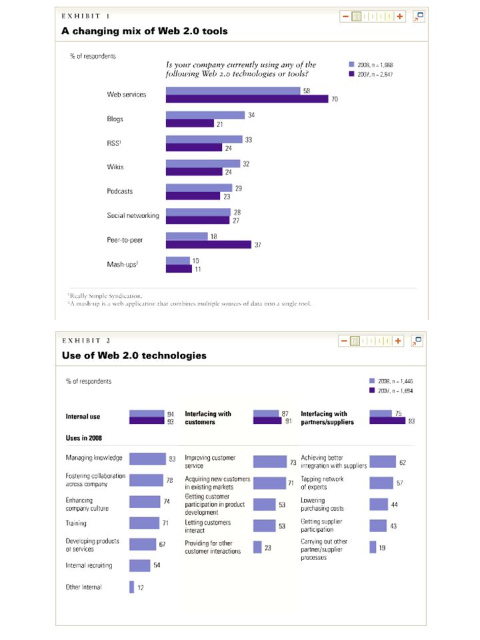
Companies use Web 2.0 technologies more frequently for internal than for external purposes, and the rate of deployment remains high for almost all kinds of uses (Exhibit 2). After an initial flurry of interest, some companies haven’t been able to sustain participation and are abandoning the use of some tools; 7 percent of respondents have tried and stopped using one or more technologiesThe survey indicates that companies are now embracing a number of potentially higher-value external objectives. Last year, for example, one key goal was to aid entry into new markets; today, more companies are focusing on interactions with their customers.
Still, there is wide variation in the level of overall satisfaction with Web 2.0 tools and technologies. Twenty-one percent of the respondents are extremely or very satisfied with them for most internal and external uses. Those who express satisfaction with these tools—either overall or solely for internal or external purposes—use them more intensively and say they are less likely to stop using them.
What matters where
Following last year’s pattern, Web services (software that makes it easier to exchange information and conduct transactions) remains the technology with the highest level of use among respondents across all regions. Respondents also rate Web services as the most important tool, with Europeans providing the highest marks. Companies in all regions perceive wikis and blogs as fairly important, and the use of both tools has increased over the past year. There are some notable regional differences in the importance of tools: for example, a larger share of respondents in North America (the birthplace of popular community Web sites such as MySpace and Facebook) than in other areas rated social networks as important (Exhibit 3).
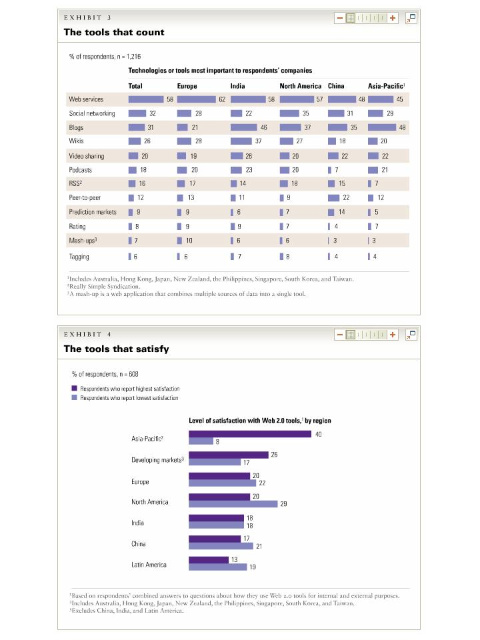
Satisfaction, like importance, varies markedly by geography. The developed countries of the Asia-Pacific region4 had the largest percentage of respondents expressing the highest level of overall satisfaction with Web 2.0 tools, and Latin America had the lowest. At the other extreme, a larger percentage of North American respondents indicated the lowest level of overall satisfaction (Exhibit 4).
Notes
Getting Web 2.0 to employees
The usage of Web 2.0 tools remains uneven among the workforce at many companies. Only about one employee in four uses Web 2.0 tools, except for Web services. But this finding masks significant differences. At the quarter of companies that are mostly satisfied with the deployment of Web 2.0 technologies, more than half of all employees are using them.
A higher level of usage is found at companies that encourage it by using tactics such as integrating the tools into existing workflows, launching Web 2.0 in conjunction with other strategic initiatives, and getting senior managers to act as role models for adoption.
As might be expected, companies whose respondents are satisfied with the overall results of Web 2.0 employ more tactics to encourage its use—an The use of incentives to encourage the deployment of Web 2.0 technologies is remarkably low; the respondents who are least satisfied with them cite a lack of incentives as a barrier twice as frequently as others doaverage of 4, compared with 2.5 at companies where respondents aren’t satisfied. Further, 35 percent of the respondents at companies that are satisfied with Web 2.0 see no organizational barriers to its greater deployment inside or outside the company. Among those who are satisfied but do see barriers, no single barrier predominates.
Inside and outside companies, many barriers to Web 2.0 persist. Dissatisfied respondents are likely to note more of them, including the inability of management to grasp the potential financial returns from Web 2.0, unresponsive corporate cultures, and less-than-enthusiastic leaders (Exhibit 5).
When Web 2.0 works
As Web 2.0 gains traction, it could transform the way companies organize and manage themselves, leading to whatAmong respondents satisfied with their companies’ use of Web 2.0 tools, only 8 percent say that these technologies have not changed their organizations—compared with 46 percent of the dissatisfied respondents some have dubbed Enterprise 2.0. This year’s survey suggests that some companies are starting to fulfill that broader promise. Among satisfied respondents, 26 percent report that Web 2.0 tools have changed interactions with customers and suppliers, while 33 percent say these technologies have created new roles or functions inside the organization. A third of the satisfied respondents even feel that Web tools are changing its structure (Exhibit 6).
Satisfied companies are using Web 2.0 tools more extensively for interactions with their customers, suppliers, and outside experts (Exhibit 7)—for example, to engage customers and suppliers in product-development efforts, also known as cocreation.5
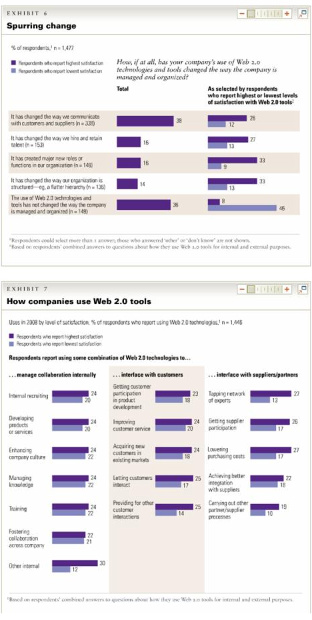
In addition, they are forming networks outside their corporate walls. These forward-thinking companies seem to be taking a more business-centric approach to the adoption of Web 2.0 as well. Satisfied respondents say that, in large measure, business units rather than IT departments are driving the selection of Web 2.0 technologies.6 Dissatisfied respondents report the reverse: IT units take the lead, choosing the tools and then delivering them to business units (Exhibit 8).7
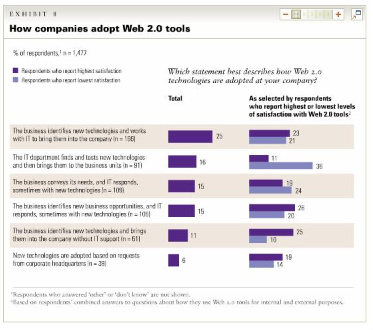
Notes
5See Jacques Bughin, Michael Chui, and Brad Johnson, “The next step in open innovation,” mckinseyquarterly.com, June 2008.
6This finding reinforces the views expressed in a McKinsey online discussion among respondents to last year’s survey on how best to introduce Web 2.0 technologies in companies.
7See Scott C. Beardsley, Bradford C. Johnson, and James M. Manyika, “Competitive advantage from better interactions,” mckinseyquarterly.com, May 2006.
Page
Looking ahead
Tougher competition. Almost 60 percent of the respondents satisfied with Web 2.0 initiatives (but only 42 percent of other respondents) see them as a driver of competitive advantage. Expect these companies to become more aggressive in the marketplace against rivals that are slower to get on board.
Higher investment levels. Satisfied or not, all companies plan to spend more on Web 2.0 tools—an opportunity for software developers.
Building Web 2.0 success. There are few differences in size, region, or even tool use between companies that are satisfied with their Web 2.0 experience and those that are not. This suggests that today’s seemingly insurmountable barriers could be overcome through the adoption of managerial methods that satisfied companies use.
Innovation. Successful companies already use Web 2.0
for business applications such as communicating with customers and suppliers;
soon they may use it to drive innovation. ![]()
About the Authors
The contributors to the development and analysis of this survey include Jacques Bughin, a director in McKinsey’s Brussels office; James Manyika, a director in the San Francisco office; and Andy Miller, a consultant in the Silicon Valley office. The authors gratefully acknowledge the contributions of their colleague Michael Chui.
'Choi's Research > 2.Contemporary Issues' 카테고리의 다른 글
| [펌] "인재 강국의 지식 사회?그 요란한 위선" (0) | 2008.11.13 |
|---|---|
| The German Bildung Tradition (0) | 2008.11.09 |
| 경영학 교육의 문제점...!! (경향 2008년 11월 11일자) (0) | 2008.11.09 |
| 경제 위기’ 경고하는 김광수 경제연구소장 (0) | 2008.07.29 |
| 미국의 신경제는 존재하지 않았다" [화제의 책]장하준 <다시 발전을 요구한다> (0) | 2008.07.20 |
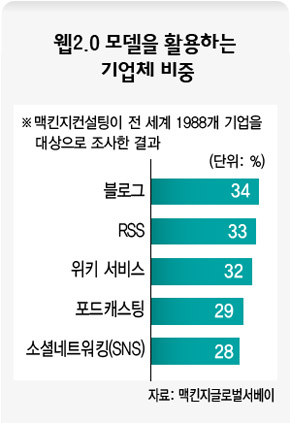

댓글